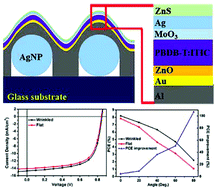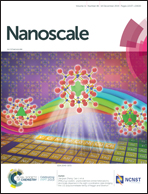A wrinkled structure with broadband and omnidirectional light-trapping abilities for improving the performance of organic solar cells with low defect density†
Abstract
Fabricating thin film solar cells on the light-trapping structures is an effective way to improve the absorption of the active layer. Here, we report a non-fullerene organic solar cell based on a PBDB-T:ITIC active layer, a wrinkled metal rear electrode, and a MoO3/Ag/ZnS front transparent electrode. Optical characterization shows that the wrinkled metal structure can remarkably increase the absorption of the active layer in a broadband range. The resulting device shows a power conversion efficiency of 8.2%, which increases by 4.6% compared to that of the flat counterpart. Apart from higher absorption, the improved performance can also be ascribed to the efficient charge transport and collection in the device due to the lower defect density, larger interfacial area, and smaller active layer thickness. A device with a power conversion efficiency of 10.19% based on the flat ITO/glass substrate is also achieved. Accordingly, a power conversion efficiency of about 10.66% is predicted under the condition where the wrinkled rear electrode and the ITO front electrode are employed. In addition, the power conversion efficiency of the wrinkled device could increase by about 50.48% compared to that of the flat device under an incident angle of 60 °C, illustrating that a better omnidirectional ability is achieved.



 Please wait while we load your content...
Please wait while we load your content...